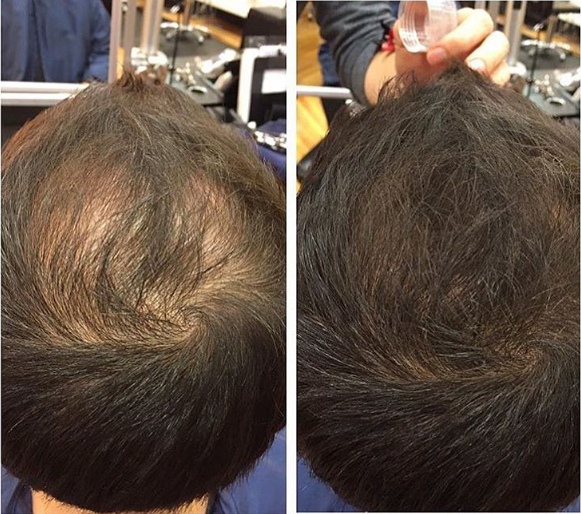Hair Fibers
Are a cosmetic solution used to create the appearance of thicker and fuller hair, often utilized by individuals experiencing thinning or hair loss. These fibers are made from keratin (the same protein found in human hair) or synthetic materials and are designed to bind to existing hair strands.
Here's how they work:
Composition
- Keratin-Based Fibers: These are made from the same protein as human hair, giving them a natural look and feel.
- Synthetic Fibers: Typically composed of nylon or other polymers, these can mimic the appearance of hair.
Application
- Hair fibers are usually applied by sprinkling or spraying them onto the thinning areas of the scalp.
- They come in a variety of colors to match different hair shades, ensuring a seamless blend.
How They Work
- Static Electricity: The fibers are charged with static electricity, which causes them to cling to existing hair strands. This creates the illusion of fuller hair by adding bulk to each strand.
- Scalp Coverage: In areas with little or no hair, the fibers can cling directly to the scalp, camouflaging the visibility of the skin.
Fixation
- To ensure the fibers stay in place, a setting spray or a light mist of hairspray is often applied. This helps lock the fibers in place and protects them from being easily dislodged by wind or light contact.
Limitations
- Hair fibers work best when there is still some hair present for them to cling to; they are less effective in areas of complete baldness.
- They are a temporary solution and wash out with shampoo.
- They may not hold up well under heavy sweating, swimming, or rain unless specifically designed to be waterproof.
Benefits
- Instant results without invasive procedures.
- Can boost confidence by improving the appearance of hair thickness.
- Easy to apply and remove.
- Prices typically range from $20 to $40 per bottle, depending on brand and size.
Hair fibers are a popular, non-invasive option for people seeking a quick and effective way to improve the appearance of their hair.

Before and after hair fibers
Scalp Micropigmentation (SMP)
A non-surgical cosmetic procedure that involves depositing tiny pigment dots into the scalp to create the appearance of a fuller head of hair or a closely shaved buzz cut. It’s often referred to as a “hair tattoo,” but the technique and results are more refined than traditional tattooing.
How SMP works:
1. Consultation and Design
- A consultation is conducted to determine the client’s goals, scalp condition, and desired hairline design.
- The practitioner designs a natural-looking hairline and decides the appropriate pigment shade based on the client’s skin tone and natural hair color.
2. Pigment Application
- The technician uses a micro-needle to apply pigment dots to the upper dermal layer of the skin.
- The dots are placed in varying sizes, densities, and angles to mimic natural hair follicles.
3. Multiple Sessions
- SMP typically requires 2–3 sessions to achieve the desired density and natural look. Each session builds on the previous one to avoid over-saturating the scalp.
- Sessions are spaced 1–2 weeks apart to allow the scalp to heal between treatments.
Uses of SMP
- Hair Loss and Thinning: Creates the illusion of thicker hair for individuals with thinning hair or diffused alopecia.
- Receding Hairline: Redefines the hairline to give a more youthful appearance.
- Complete Baldness: Simulates the look of a closely shaved head.
- Scar Camouflage: Conceals scars from hair transplant surgery or scalp injuries.
- Alopecia Areata or Totalis: Offers a consistent appearance of hair coverage.
Benefits of SMP
- Natural Appearance: Provides realistic results that mimic natural hair follicles.
- Long-lasting: Results can last 4–6 years with proper care, although periodic touch-ups may be needed.
- Non-Invasive: No surgery, incisions, or lengthy recovery periods.
- Versatile: Suitable for all skin tones and types of hair loss.
- Low Maintenance: Once healed, requires minimal upkeep.
Limitations and Considerations
- Healing Time: Minor redness or sensitivity may occur for a few days post-treatment.
- Color Fading: The pigment may fade over time, especially with excessive sun exposure.
- Not Hair Growth: SMP creates the appearance of hair but does not stimulate actual hair growth.
- Specialist Required: Results depend heavily on the skill and experience of the practitioner.
Costs
- SMP costs typically range from $1800 to $4000, depending on the extent of hair loss and the practitioner’s experience.
SMP is an innovative and effective solution for individuals looking to address hair loss without surgery, providing an immediate and low-maintenance option for enhancing their appearance.

Before and after scalp micropigmentation
Wigs
- Lace Front Wigs: Natural hairline, $100-$500+
- Full Lace Wigs: Versatile styling, $200-$1000+
- Synthetic Wigs: Budget-friendly, $50-$200
- Human Hair Wigs:Natural look, $500-$5000+
Hair Systems
- Stock Systems: Pre-made, $200-$500
- Custom Systems: Tailored fit, $1000-$3000+
- Prices vary based on quality, brand, and customization. Consult a hair loss professional for personalized advice.

Hair system fitting procedure